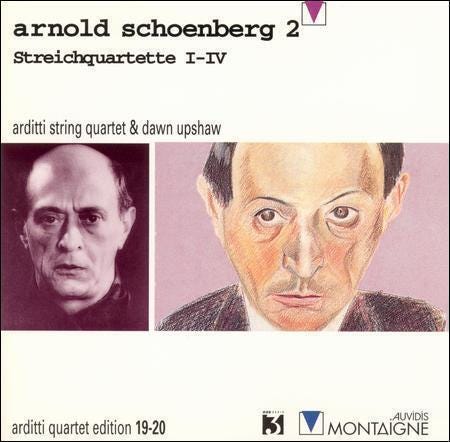Genre of the Day - Serialism
Album of the Day - Schoenberg: Streichquartette I-IV by Arnold Schoenberg
Today’s genre, serialism, which is essentially a branch of classical music popular among mid-20th century composers, was completely out of left field for me in terms of name recognition. However, this genre became even more esoteric to me upon trying to gain even a cursory knowledge of it. It befuddles; its definition still eludes me (and seemingly scholars?) after reading about it; it seems entirely antithetical to what the popular definition of what music ‘should be.’ Serialism is described as a method of composition originating in Arnold Schoenberg’s twelve-tone technique. Ever so Germanic, Schoenberg and his peers approached music in a thoroughly analytical way. The goal of the twelve tone technique is to use all 12 notes of the chromatic scale ‘as often as one another’ in a piece. This somehow prevents the music from being in one key, which is some advanced ass music theory I can’t begin to understand. I fear I never even really mastered the Circle of Fifths in my piano lessons, so I certainly felt out of my element but intrigued upon delving into this unorthodox genre.
I’m going to be forthright here: I did not finish today’s album. This is not fully due to the music, but more due to the fact that the songs average around 8 minutes leading to a runtime of nearly 2 and a half hours. I listened to as much as I could before going to hang out with a friend and upon returning home I fear it’s just genuinely too late to finish. However, I don't think that’s particularly detrimental to my understanding of the album. I am almost positive I’ll continue to encounter such intimidatingly long albums in this journey and will commit better to the goal of full completion, but it’s winter break! And also, this music is quite terrifying.
The mixing of twelve-tonal technique with a violin quartet across four different opuses yields some of the most frightening, frantic, genuinely ominous music my ears have ever heard. In my roughly one and a half hour listen, I was awash under a constantly moving cascade of Psycho-esque strings. Towards the middle, an opera singer appears for some time, which doesn’t really alleviate the fear-inducing sound but actually drives more frenzied energy into the music. Also, can someone explain if she is singing atonally? Can music theory nerds just tell when something is atonal? Anyway, whether the alarming sound is an inevitability of the methodological approach of serialism or simply a stylistic preference of Schoenberg is something I don’t really understand, but essentially every top serialism album on RYM is marked with some combination of anxious, ominous, or dissonant.
Did this expand my understanding of music, especially classical music? Yes. Do I wish I knew a little music theory to better grasp what the hell is going on here? Yes. Is this recommendable music or relistenable on any regular basis? Absolutely not, except maybe only to a very specific type of music nerd or really impassioned, curious violin players or fans. This is music my mind admittedly chafes against, not just because of the generally unsettling nature of it, but because the atonality of the pieces does make it quite impossible for one to ground oneself within the melodies. This is something that, upon researching the genre, I found music theorists also criticizing. I think only in a peculiar mood would I revisit this. However, I think exploring this genre had real value by making me ponder what makes music musical, and shows that this is a topic that is very much open for debate. It reminds me that as music has the capacity to move and make one feel emotion, it also has the capacity to frighten and serve as an object of analytical, almost mathematical inquiry.
I fear Music Theory for Dummies should probably be next on the reading list.
EDIT: Am I boo boo the fool or what!!! Literally 2 minutes after posting this I went to finish reading through the few RYM reviews only to discover I’d made a massive mistake: the first two opuses, which constituted the bulk of my listening as I only got through two songs of opus III, aren’t even atonal! I felt especially stupid seeing that the songs LITERALLY SAY ‘en Ré Mineur’ and ‘en Fa-Sharp Mineur.’ So basically I guess ominous, scary music is just Schoenberg’s style whether he’s composing atonally or tonally.





I read "The Complete Idiot's Guide to Music Theory" and I can recommend it for music genre nerds with lack of formal training, like you and myself. But Music Theory for Dummies is probably similar.